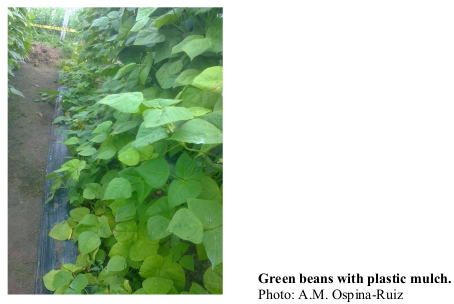Estudio técnico y económico de variedades comerciales de habichuela con cobertura plástica

Resumen
Las habichuelas se consumen en todo el mundo debido a sus propiedades nutricionales saludables. Estas hacen parte importante de la dieta moderna "Grab-and-Go", junto con la dieta tradicional. Las habichuelas son ricas en proteínas, vitaminas, fibra, ácido fólico y numerosos minerales. En Colombia, la producción de habichuela se concentra en la cordillera Oriental donde actualmente se presentan bajos rendimientos por los problemas fitosanitarios asociados a la variedad tradicional Blue Lake, sumado a la poca implementación de estrategias de producción como lo son los acolchados plásticos. Así, se evaluó técnica y económicamente cuatro variedades de habichuela con acolchado plástico. El diseño experimental utilizado fue bloques completos al azar con ocho tratamientos, resultado de la combinación de los factores, variedad (UNAPAL Milenio, Blue Lake Pole, Blue Lake Nacional y Bue Lake S-7) y con y sin acolchado plástico, con cuatro repeticiones y una unidad experimental de 25 plantas. Las distancias de siembra fueron a 0,25 m entre plantas y 1,2 m entre surcos para una densidad de población de 33.333 plantas/ha. Las variables evaluadas fueron: componentes de rendimiento, producción por planta (g) y rendimiento del cultivo (t ha-1). El acolchado plástico (negro-negro) no tuvo efecto diferencial en el comportamiento agronómico de las variedades de habichuela en la zona de estudio. La variedad UNAPAL Milenio con 9.134 kg ha-1, alcanzó un comportamiento agronómico similar a la variedad convencional Blue Lake con 9.717 kg ha-1. La variedad Blue Lake presentó el mejor comportamiento económico con una relación beneficio-costo de 1,15 y una tasa de rentabilidad de 14,85%.
Palabras clave
Phaseolus vulgaris L., Plasticultura, Productividad, Rentabilidad, Componentes del rendimiento
Biografía del autor/a
Alejandro Hurtado Salazar
Departamento de Produccion Agropecuaria
Citas
- Agronet. 2023. Cifras Agropecuarias. In: https://www.agronet.gov.co/estadistica/Paginas/home.aspx?cod=1; consulted: January, 2023.
- Arbeláez, L., J. Rivera, A. Hurtado-Salazar, and N. Ceballos-Aguirre. 2016. Technical and economic evaluation of three types of tomato nutrient solutions under semi-controlled conditions. J. Agric. Sci. 8(8), 68-78. Doi: https://doi.org/10.5539/jas.v8n8p68
- Blair, M.W., A. Chaves, A. Tofiño, J.F. Calderón, and J.D. Palacio. 2010. Extensive diversity and inter-genepool introgression in a world-wide collection of indeterminate snap bean accessions. Theor. Appl. Genet. 120, 1381-1391. Doi: https://doi.org/10.1007/s00122-010-1262-4
- Calero, A., Y. Pérez, Y. González-Pardo, L.A. Yanes, K. Peña, D. Olivera, and J.F. Meléndrez. 2020. Respuesta agroproductiva de la habichuela a la aplicación de vermicompost lixiviado y microorganismos eficientes. Rev. Fac. Cienc. 9(1), 112-124. Doi: https://doi.org/10.15446/rev.fac.cienc.v9n1.82584
- Cenicafé, Centro Nacional de Investigaciones de Café Colombia. 2022. Anuario meteorológico cafetero 2021. Chinchina, Colombia. Doi: https://doi.org/10.38141/10782/anu2021
- Colombia DANE, Departamento Nacional de Estadística. 2013. Encuesta Nacional Agropecuaria - ENA - 2013 - I - Semestre. In: http://microdatos.dane.gov.co/index.php/catalog/677; consulted: February, 2023.
- Colombia DANE, Departamento Nacional de Estadística. 2016. Cultivo de la habichuela (Phaseolus vulgaris L.) y el fenómeno de El Niño. Boletín Mensual No. 43: insumos y factores asociados a la producción agropecuaria. Bogota.
- Colombia DANE, Departamento Administrativo Nacional de Estadística. 2023. Sistema de Información de Precios y Abastecimiento del Sector Agropecuarios (SIPSA)-Componente precios mayoristas diario. 2022. In: https://www.dane.gov.co/index.php/estadisticas-por-tema/agropecuario/sistema-de-informacion-de-precios-sipsa/componente-precios-mayoristas; consulted: January, 2023.
- Fischer, G., J.A. Cleves-Leguizamo, and H.E. Balaguera-López. 2022. Impact of soil temperature on fruit species within climate change scenarios. Rev. Colomb. Cienc. Hortic. 16(1), e12769. Doi: https://doi.org/10.19053/rcch.2022v16i1.12769
- Gao, H., C. Yan, Q. Liu, W. Ding, B. Chen, and Z. Li. 2019. Effects of plastic mulching and plastic residue on agricultural production: A meta-analysis. Sci. Total Environ. 651(Part 1), 484-492. Doi: https://doi.org/10.1016/j.scitotenv.2018.09.105
- Hernández, L., N. Hernández, F. Soto, and M.A. Pino. 2010. Estudio fenológico preliminar de seis cultivares de habichuela de la especie Phaseolus vulgaris L. Cul. Trop. 31(1), 54-61.
- Herrera, H.J., A. Hurtado-Salazar, and N. Ceballos-Aguirre. 2015. Estudio técnico y económico del tomate tipo cereza élite (Solanum lycopersicum L. var. cerasiforme) bajo condiciones semicontroladas. Rev. Colomb. Cienc. Hortic. 9(2), 290-300. Doi: https://doi.org/10.17584/rcch.2015v9i2.4185
- Kabir, H., M. Musharraf, M.M. Haque, and M. Khan. 2015. Technical efficiency of boro rice production in Bangladesh: A case of bio-slurry application. J. Bangladesh Agric. Univ. 13(1), 101-108. Doi: https://doi.org/10.3329/jbau.v13i1.28725
- Martínez-Reina, A., L. Tordecilla-Zumaqué, C. Cordero-Cordero, and L. Grandett-Martínez. 2019. Entorno tecnológico y socioeconómico de la habichuela larga en el Caribe Húmedo de Colombia. Cienc. Agric. 16(2), 7-24. Doi: https://doi.org/10.19053/01228420.v16.n2.2019.9114
- Obando, F.H., A.M. Villegas, J.H. Betancur, and L. Echeverri. 2006. Variabilidad espacial de propiedades químicas y físicas en un Typic Udivitrands, arenoso de la región andina central colombiana. Rev. Fac. Nac. Agron. Medellin 59(1), 3217-3235.
- Petropoulos, S.A., A. Fernandes, S. Plexida, A. Chrysargyris, N. Tzortzakis, J.C.M. Barreira, L. Barros, and I.C.F.R. Ferreira. 2020. Biostimulants application alleviates water stress effects on yield and chemical composition of greenhouse green bean (Phaseolus vulgaris L.). Agronomy 10(2), 181. Doi: https://doi.org/10.3390/agronomy10020181
- PQA. 2023. Productos y servicios, In: Productos químicos andinos, https://www.pqapag.co/; consulted: February, 2023.
- San-Miguel, J., C.A. Montoya, I. Lores, C.J. Arreola, and J. Vera. 2021. Respuesta productiva de la habichuela (Vigna unguiculata Sub sp sesquipedalis) al efecto de Mudra Extra®. Hombre, Ciencia y Tecnología 25(4) 1-8.
- Tofanelli, M.B.D. and S.E. Wortman. 2020. Benchmarking the agronomic performance of biodegradable mulches against polyethylene mulch film: A meta-analysis. Agronomy 10(10), 1618. Doi: https://doi.org/10.3390/agronomy10101618
- Vallejo, F. and E. Estrada. 2004. El cultivo de la habichuela. pp. 269-290. En: Vallejo, F. and E. Estrada (eds.). Producción de hortalizas de clima cálido. Universidad Nacional de Colombia, Palmira, Colombia.
- Villota, M.A., L.E. Saavedra, and S.H. de Cantillo. 1993. Eficiencia de la fertilización convencional frente a la fertilización completa en habichuela, Phaseolus vulgaris L., en un suelo de Pradera, Valle del Cauca. Acta Agron. 43(1-4), 121-133.
- Zribi, W., J.M. Faci, and R. Aragüés. 2011. Efectos del acolchado sobre la humedad, temperatura, estructura y salinidad de suelos agrícolas. Inf. Téc. Econ. Agrar. 107(2), 148-162.
